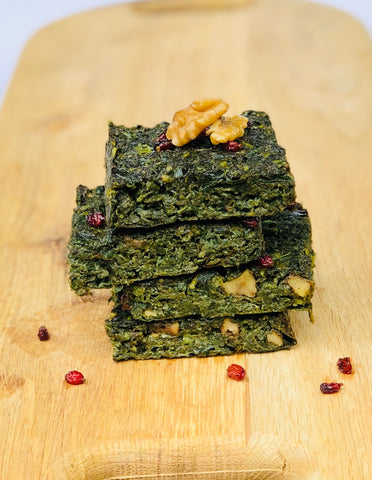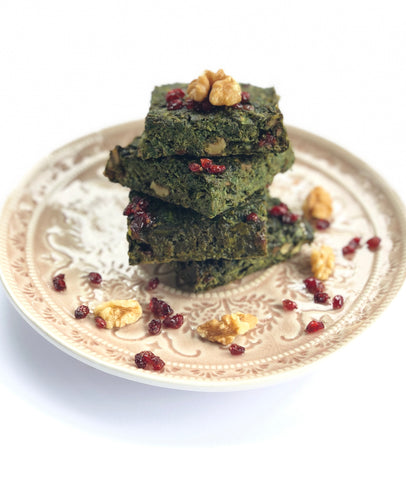In Australia, we are privileged to live in a diverse society that celebrates various traditions and festivals. Among these, Nowruz, the Persian New Year, holds significant importance. Nowruz, heralding the arrival of spring, signifies renewal, growth, and hope. Amidst the array of customs and rituals associated with Nowruz, one culinary delight stands out: Kuku Sabzi, the vibrant Persian frittata. This blog explores the traditions behind Kuku Sabzi, and its health benefits, and shares a delightful recipe for you to enjoy any time of the year.
Why Kuku Sabzi at Nowruz?

Nowruz, meaning "New Day," is deeply ingrained in Persian culture, with roots tracing back thousands of years. Falling on the vernal equinox, Nowruz marks the onset of spring and the end of winter. As nature awakens from its slumber, Nowruz celebrations revolve around themes of rejuvenation, rebirth, and prosperity.
Kuku Sabzi holds a special place in Nowruz festivities for several reasons. Firstly, its vivid green colour mirrors the lush landscapes of spring, symbolizing the abundance and freshness of the new season. Secondly, the ingredients used in Kuku Sabzi, brimming with fresh herbs, often signify the first greens to emerge post-winter, making it an emblematic dish for welcoming spring. Lastly, preparing and sharing Kuku Sabzi with loved ones fosters a sense of community and togetherness, encapsulating the essence of Nowruz and exactly what we are all about here at Exotic Bazaar.
Traditions and Symbolism:
Beyond its culinary appeal, Kuku Sabzi is steeped in tradition and symbolism, and this is another thing we love at Exotic Bazaar. Kuku Sabzi typically features a medley of fresh herbs like parsley, cilantro, dill, and green onions, each herb carries its own significance. Parsley symbolizes joy and celebration, while dill is associated with prosperity and good fortune. As families gather around the Nowruz table, Kuku Sabzi serves as a flavorful representation of the blessings and abundance that the new year brings.
Health Benefits of Kuku Sabzi:
Apart from its cultural significance, Kuku Sabzi boasts numerous health benefits. Laden with the variety of nutrient-rich herbs, Kuku Sabzi serves as a powerhouse of vitamins, minerals, and antioxidants. These abundant herbs are renowned for their anti-inflammatory properties, digestive benefits, and overall health support. Furthermore, Kuku Sabzi's versatility, whether enjoyed hot or cold, makes it a perfect addition to any meal or snack.
Kuku Sabzi Ingredients and Varieties:

Kuku Sabzi typically comprises a base of eggs mixed with an assortment of fresh herbs, sometimes complemented by additional ingredients like nuts or vegetables. Think of Kuku Sabzi as a Persian omelette or frittata, with parsley, cilantro, dill, and green onions as the traditional staples. Many variations include spinach, fenugreek, mint, or leeks. Some recipes incorporate spices such as turmeric or cumin to enhance flavour complexity.
Recipe: Your Homemade Persian Herb Frittata

Now, let's explore creating your own 'exotic' omelette - Kuku Sabzi at home! Here's a simple yet delectable recipe to tantalize your taste buds, it's super easy:
Ingredients:
- 7 large free-range eggs
- 2 cups of mixed fresh herbs -parsley, cilantro, and garlic chives, finely chop them together.
- 1 cup spinach, finely chopped
- 1 small bunch of green onion, finely chopped top to bottom
- 2-3 cloves garlic, minced
- Handful of chopped walnuts
- 1/2 teaspoon turmeric
- Salt and pepper to taste
- Olive oil for frying
- (Optional) 1/2 teaspoon baking powder
Kuku sabzi Instructions:
- Whisk the eggs until frothy in a large mixing bowl, seasoning generously with salt and pepper.
- Add the chopped herbs and walnuts (save some walnuts for the garnish) to the eggs, ensuring a thorough mix.
- Heat olive oil in a non-stick frying pan over medium heat and add the green onion. Fry for a minute.
- Pour in the egg and herb/spinach mixture into the pan, distributing it evenly.
- Like you would a regular omelette, cook for approximately 5-7 minutes until the bottom is golden brown and set.
- Carefully flip the Kuku using a spatula and cook for an additional 5-7 minutes until both sides are golden.
- Once cooked through, allow the Kuku to cool slightly before slicing into wedges.
- Serve warm or at room temperature, accompanied with natural or Greek yoghurt and/or a squeeze of lemon for added zest.
- Garnish with walnuts and barberry (optional)

Enjoy your homemade Kuku Sabzi as a standalone dish, or get creative by incorporating it into sandwiches or wraps for a delightful lunchtime meal experience! I love Kuku Sabzi in a baguette with fresh tomato, mayo and pickles 🙂
Kuku Sabzi transcends mere culinary delight; it embodies the essence of Nowruz. As we gather with loved ones to celebrate the arrival of spring, let's savour the traditions and flavours that make this festive occasion truly memorable. Here's to a joyous and prosperous Nowruz filled with love, laughter, and the finest Kuku Sabzi - because, of course, ours is the best recipe!
Bonus: Explore More Persian Flavours with Exotic Bazaar
Looking to further immerse yourself in Persian cuisine? Visit Exotic Bazaar, where you can find our Persian Love Cake baking kit, an exquisite dessert that's sure to delight your senses and add a touch of indulgence to your Nowruz celebrations.
See More About The Persian Love Cake Baking Kit Here





Comments (2)
Hi Gilla
Preparing Kuku Sabzi
On the weekend.
Sharing with neighbours around the fire.
Looking the life in the country
Lots of love Yara 🤗
You used to sell your Persian love cake in a pink box which made it ideal as a gift. Do you plan to return to this?